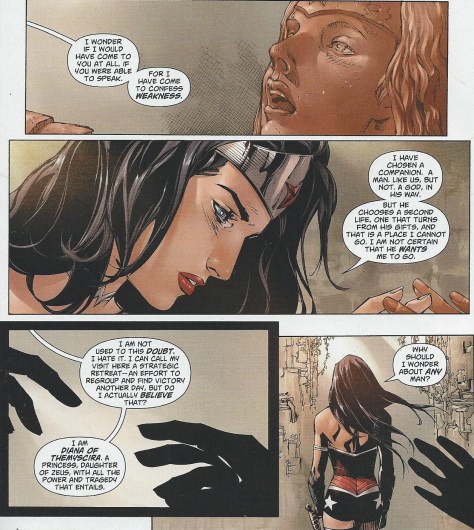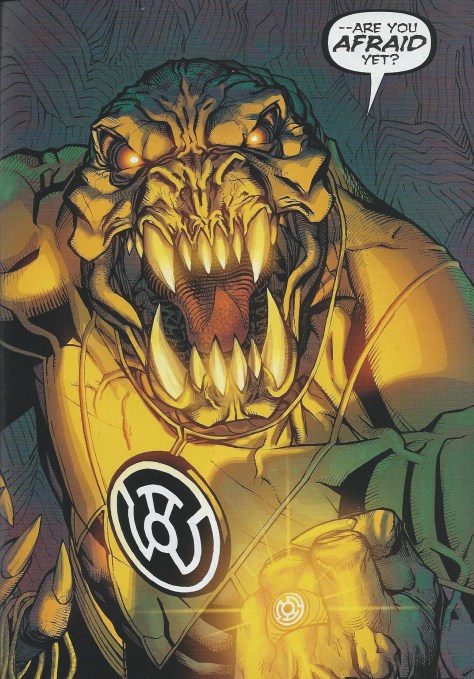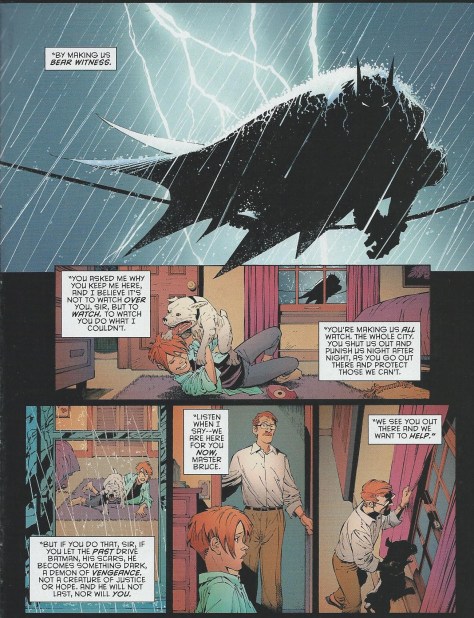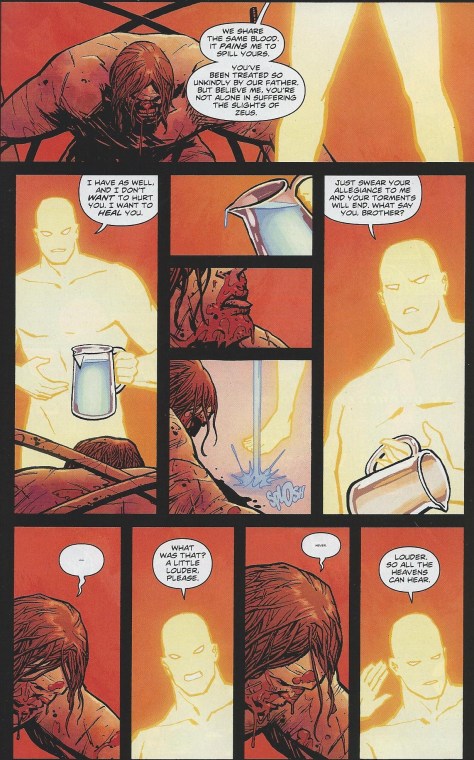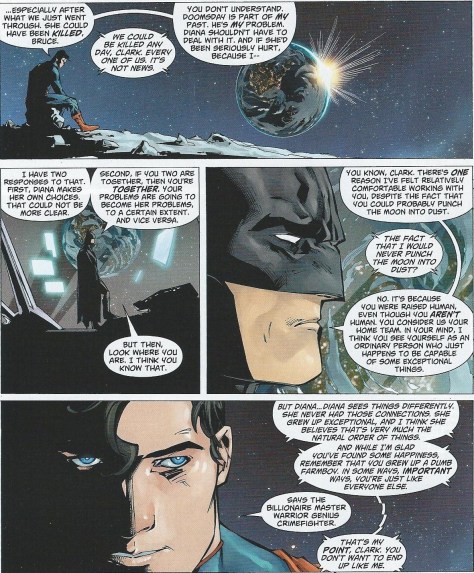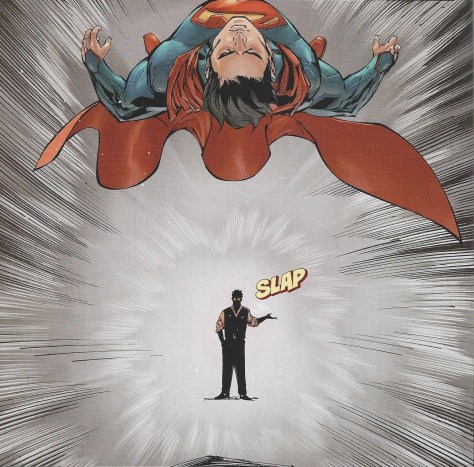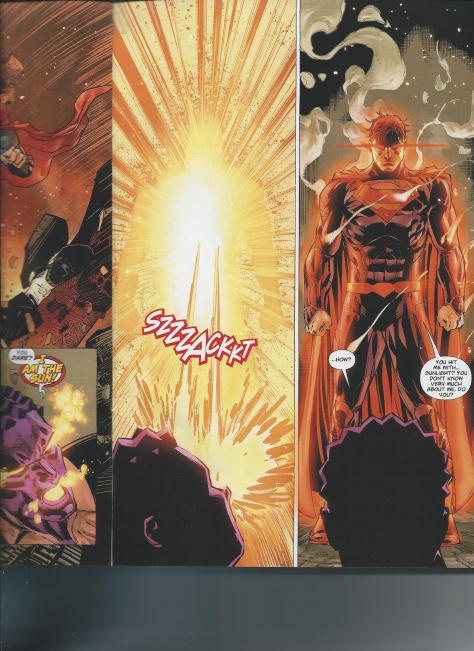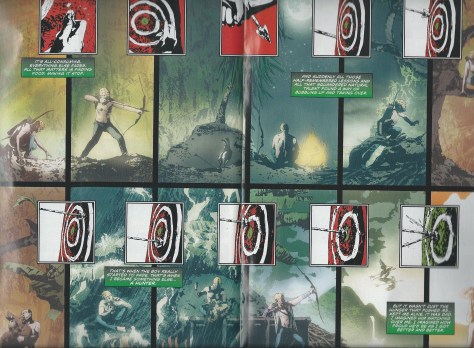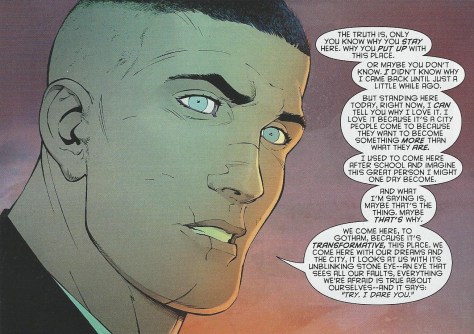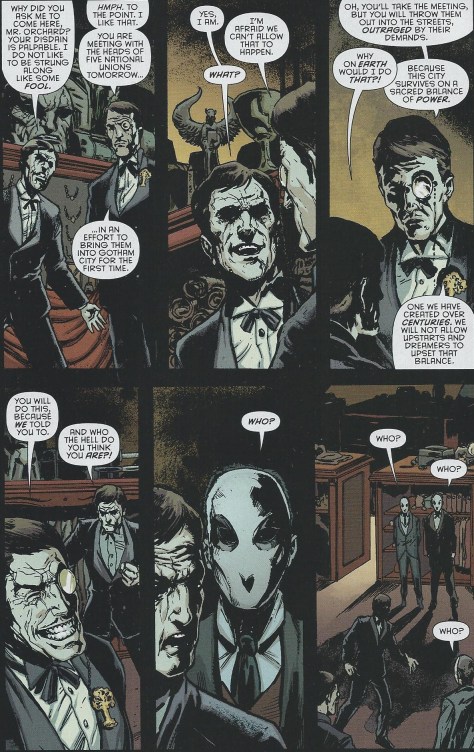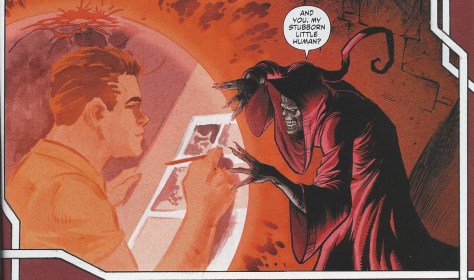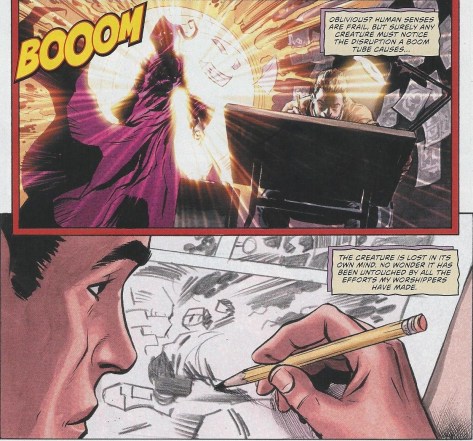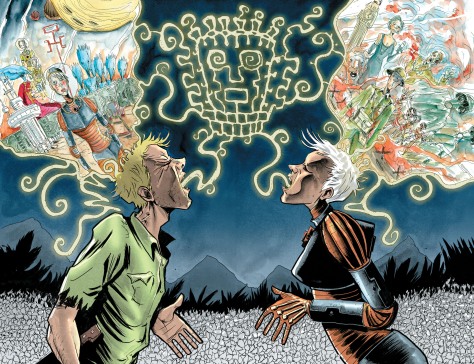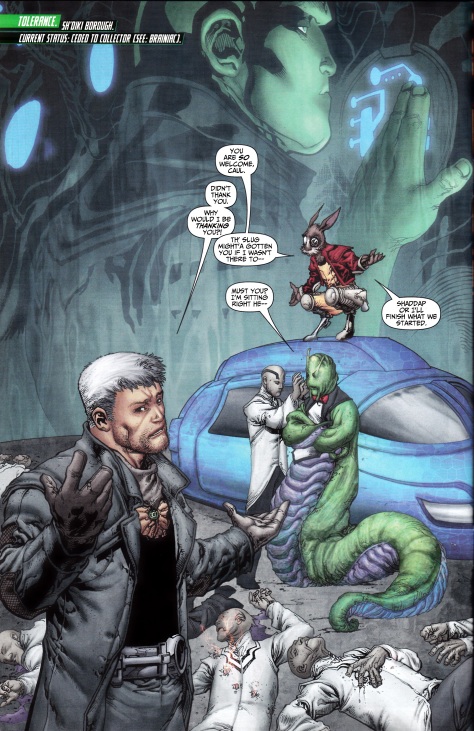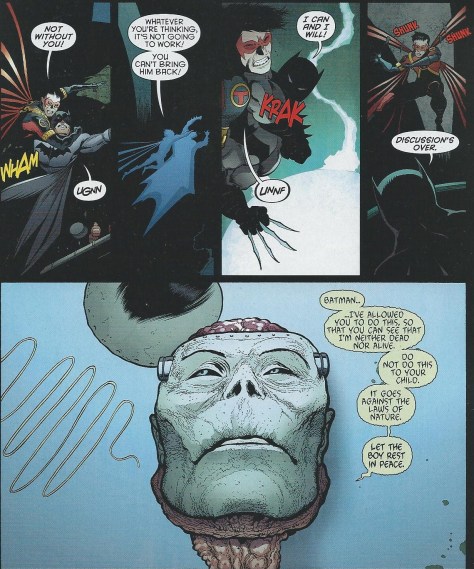With this last week of September comes the last installments of Villains Month. Personally, I am really excited about the Sinestro, Doomsday, Man-Bat, and Parasite issues, and intrigued by several others out this week. So far Villains Month hasn’t been a disappointment. There have been some truly amazing stories told and I look forward to seeing what this week adds to the phenomenal work already done.
- Justice League #23.4: The Secret Society acts as the bridge between Forever Evil and the rest of Villains Month. Mired in secrets, writer Geoff Johns is clearly setting up reveals for the final or penultimate chapters of his Forever Evil series and stringing readers along for the ride. There is a very engrossing narrative in this issue, with the meat of revelation coming from what is said outside of the story juxtaposed against little things mentioned in dialogue. The issue opens with Alfred Pennyworth of Earth-3, the Outsider, telling the reader that he and Owlman each have a secret. Going forward we see how a Wayne family of four, consisting of Martha and Thomas Wayne and their two sons running for their lives through an alleyway. They are stopped at gunpoint and told to empty out their pockets and their purse . . . in the name of the law. Since this is Earth-3, of course the benevolent Wayne family would be degenerate criminals. What happens next is masked from sight, and the narrative jumps to the “present” with a fully realized Owlman, who has subjugated Gotham entirely under his absolute control, racing across rooftops, in pursuit of the Joker and searching for his errant side-kick, Talon. The Talon is in fact still Dick Grayson and his parents were still murdered. Alfred mentions offhandedly that Owlman should never have told Dick the truth, which insinuates that Owlman killed them to make Dick into something else. Alfred also says that Dick was the closest thing Owlman had to a brother, something that even Bruce couldn’t provide him. It was said before both in Justice League #23 and Forever Evil #1, but Owlman is NOT the Bruce Wayne of Earth-3. He’s the Batman archetype that fills that role, but Bruce was killed with his parents at the beginning, or so it would seem. Owlman is Thomas Wayne, and taking into account the mention by Alfred of Bruce not being the brother he needed, the revelation that Alfred killed both Thomas’s parents, and the shot at the beginning of four Waynes running for their lives, it can be deduced that Thomas is Thomas Wayne Jr. The double intrigue for me comes with the earlier introduction of a Thomas Wayne Jr in Scott Snyder’s inaugural arc of Batman entitled the “Court of Owls” in which Bruce’s supposed brother becomes a near Owlman facsimile in our reality. I wonder which came first, Snyder’s Thomas Jr or Johns’, because as far as I can recall, Owlman of Earth-3 has always been Bruce Wayne in past CSA stories. Either way, Dick is an integral piece in this puzzle for many reasons and it’s that bond that is so crucial in Owlman’s undoing. The Joker, being an antagonist of Owlman and a denizen of Earth-3, is conversely a force for good. He is a force of chaos that stands to topple absolute power unilaterally wielded in Gotham by Owlman. He is also a man that despite his madness is touched by human suffering and fights to free his city of it. But in a world with absolute evil omnipresent, a hero like the Joker is a very stark hero indeed, as evinced by the five “gifts” the Joker gives to Owlman. Not long after their ultimate encounter the skies turn red and Owlman is informed by Ultraman that something is attacking their world. Another jump in time brings the reader to the moment which began the New DCU starting with the events of Justice League #1. The Outsider and Atomica enter our world by unknown means with the rest of the Crime Syndicate of America left on Earth-3. It was this glimpse that we saw at the end of Justice League #6 a year and a half ago when the Outsider began recruiting for the Secret Society. What this issue did that was the most interesting was qualifying the capture of Nightwing by the CSA and what it really means in the long term. I have developed mixed feelings about Geoff Johns’ writing of late, but he’s legitimately got me excited about Forever Evil. Don’t screw it up, Geoff.


The Joker. This is What a Hero Looks Like on Earth-3.
- Action Comics #23.4: Metallo is the second Superman themed Villains Month issue that Sholly Fisch, Action Comics backup writer during Grant Morrison’s run, attempts. Like Bizarro in the first batch of villains, this one played to Morrison gold, but fell a little flat. John Corben has always been a psychotic, but this issue did nothing to elaborate on that or do anything interesting. Corben was in a coma after the events of Action Comics #8, and this issue picks up on General Sam Lane’s attempts to wake him up with as many government and military resources as he can muster. Corben continues his sociopathic tendencies, eliciting nothing interesting to readers, but rather making us question why the HELL Sam Lane has so much faith in such a giant loser. But even Sam Lane’s patience is pressed as the issue unfolds. After reading this, I don’t feel enlightened or entertained, which seems like a wasted effort.
- Aquaman #23.2: Ocean Master was somewhat unpleasant to read, but that isn’t to say that it wasn’t extremely good. On the contrary, it was a very honest, stark look at the character of the deposed king of Atlantis and Aquaman’s little brother, Orm. Growing up beneath the sea and never experiencing the upper world, coupled with the tragic events of his ill-informed, disastrous invasion of the United States, he has a very misanthropic attitude towards humanity and this issue showcases that quite vividly. But like any person sat down to look at a passionate figure that stands up against the evils that their own way of life perpetuates, it is both intriguing and hard to see him HATE humans so much and so stubbornly. “We aren’t all like that,” you might say, but unfortunately enough people are to warrant his hatred and this issue portrays that very well. However, his inability to see outside of his hate does remain a serious issue that taints his credibility as a mouthpiece for his cause. In these Villains Month issues I find myself asking throughout several, “Is this person really that bad or do they still have something left inside them that makes them not evil?” Again, I maintained from the start that Orm was a noble man that ruled justly, because of his honor and moral stength. Throughout this issue and considering what happened to him after the Atlantean War he is tested to the breaking point, but whether he breaks or weathers the storm is something that will have to be discovered by reading this issue. A moment in this issue appropriate to this topic is the encounter he has with a guard who recognizes his bitter succeptibility to dehydration and goes out of his way to make sure Orm is given water to prevent discomfort and the later meeting with him following the opening of Belle Reve when that same guard is badly hurt. It is in that encounter along with the issue’s last panel after he rebukes a terrified mother’s entreaties to saved her eight year old son from being murdered by escaped Belle Reve convicts that Orm’s character is TRULY revealed to readers. Once again Tony Bedard steps in and writes Geoff Johns’ Aquaman stories for him, as he did with the Black Manta issue. You can feel Geoff Johns’ influence in the plot, but the writing has all of Bedard’s subtlety and skill. Geraldo Borges provides pencils on this special issue and proves to be an apt choice, mimicking the beautiful style of Ivan Reis, who began this title with Johns solidifying the feel of it. Overall, I love the character of Orm (Ocean Master) and I am impressed with how Bedard and Johns have treated him in it. Definitely something worth reading.

A King’s Mercy.
- Green Lantern :23.4: Sinestro is another issue, like Ocean Master above, that aptly captures the essence of greatness and the cost of that destiny. Sinestro is perhaps one of the most complex characters that has emerged in modern comics. On one side he was the greatest Lantern that ever lived (unless you are of the Hal Jordan camp), epitomizing great strength of mind, body, and will, but conversely he is also a man who is very haughty, callus, and harsh. Writer Matt Kindt takes up the history of Sinestro from the perspective of Lyssa Drak, former Yellow Lantern and archivist of the Book of Sinestro (the Yellow Lantern’s official history and ledger). Though far from objective, she was imprisoned by Sinestro when he became a Green Lantern again, so she has reason to dislike him as much as she does to revere him. Through her eyes we see Sinestro before he received his ring and the path he took once he embraced his new role as intergalactic watchman. That path is circuitous to be sure and fraught with both misdeed and virtue. From the moment he gets the ring he makes tough decisions that he judges are for the greater good, and truly despite small evils his people and those of his sector of space are better for it . . . for a time. But as he continues to sacrifice and work toward the betterment of his planet Korugar he moves down a dark path that begins to separate him from his “humanity.” Kindt shows his marriage to Arin Sur, the sister of his best friend in the Green Lantern Corps, Abin Sur (predecessor of Hal Jordan), and how even his deep seemingly unending love for Arin could not match his devotion to “protecting” his people through tyrannical means. I am not sure if Kindt is a student of history, but his writing of this issue really rings true in its parallels to the rise of many dictators in our own planet’s history. But despite his despotic overtones, Lyssa makes a very compelling point. Throughout the many troubles that have befallen them during his lifetime, Sinestro was always there when he was needed. Despite the destruction of his homeworld by the First Lantern, the survivors of Korugar will need him in coming days. The question remains if he will return to guide them when they need him the most?
- Batman/Superman #3.1: Doomsday was a very complex story and one I am not quite sure I understood entirely. Luckily, I know that this issue is functioning as a precursor for a Doomsday arc in the Batman/Superman title, which is likewise being done by this issue’s creative team, writer Greg Pak and artist Brett Booth. Both bring out their A-game and further the mythological development of Old Krypton. Opening on a Kryptonian holiday called “Remembrance Day” the Brothers El seem to be of at peace with the observation, but their wives are quite the opposite. Alura Zor-El is more of the mind to remember the carnage it embodies. Lara Jor-El, who was at the forefront of the incident the holiday commemorates, is also cynical of its true purpose, choosing to call it “Doomsday.” As she begins to recount her tale the time frame is uncertain, but can’t be more than five or six years prior considering the physical depictions of the characters past and “present.” Lara rushes home in full Kryptonian armor bearing the crest of her husband’s family proudly on her chest, and gets Jor-El to safety before going after a monstrous beast that is tearing the capital to pieces. We know from the sight of it that this is the beast called “Doomsday.” It is strong. It is unstoppable. It is without conscience, thought, or motivation besides wanton death and destruction. There truly is no defeating the beast and it bears down on Lara after a long fight she and many other heroes of Krypton make against it. She is going to die, before salvation comes in the form of Col. Dru-Zod and his chosen elites. The actual ending of this story is cut off as the very young Kara Zor-El, future Supergirl, is awoken and cries out in terror, prompting her father, Zor-El, to go in and talk to her. When he tries to explain what happened to the monster and later to General Zod, sugar coating it, she demands to know the truth and not just kid stories. For whatever reason Zor-El tells her a story of the “Last Knight of the House of El” and his battle with this beast on another world. It is told like a fairy tale and the details exaggerated, but what writer Greg Pak really does is reassert the “Death of Superman” story from 1992 in battle with Doomsday. Though it still is a kid story and has a “happy ending” Kara accepts it and acknowledges that she will someday be a knight like in the story. What follows is where my uncertainty enters. After her father leaves, the “ghost” of General Zod comes out of Kara’s closet and begins speaking with her about the truth of the Doomsday attack. From his rhetoric there is an ambiguity of whether Zod knows anything about where the beast came from, if he is responsible for its creation and unleashing, is not responsible but just thankful for it, or whether he IS the beast, as well. His ghost takes the shape of Doomsday several times making it seem like the latter most possibility is the case, but his words seem to vacillate back and forth. What is certain is his intention for Krypton is to make it strong through trauma and keep his people’s spirits sharp through hardships that will ensure their vigilance. Though she’s only a child, Kara stands up to one of the greatest boogeymen of Kryptonian history like a champ. This issue sets up a great many things to be clarified in future comics, but it also reinforces a great many things we have seen of Krypton’s past just before its destruction. Lara is shown to be the valiant soldier and her husband Jor-El to be the visionary scientist and dreamer. Zor-El is characterized as a selfless, loving father. Kara is a tough-as-nails daughter of El that doesn’t give an inch, even as a tiny girl, literally facing down the monster that lives in her closet. Great issue on all fronts.
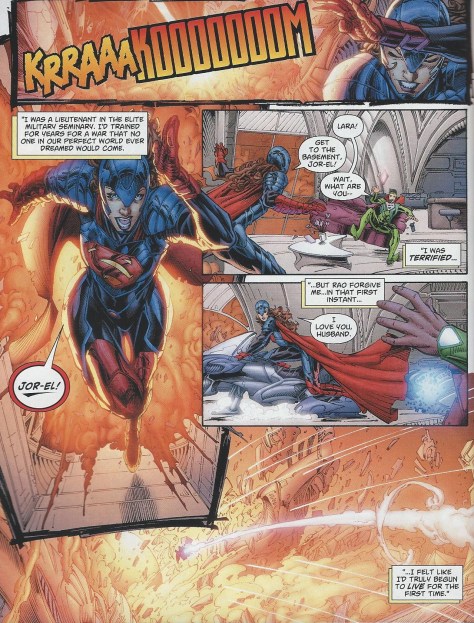
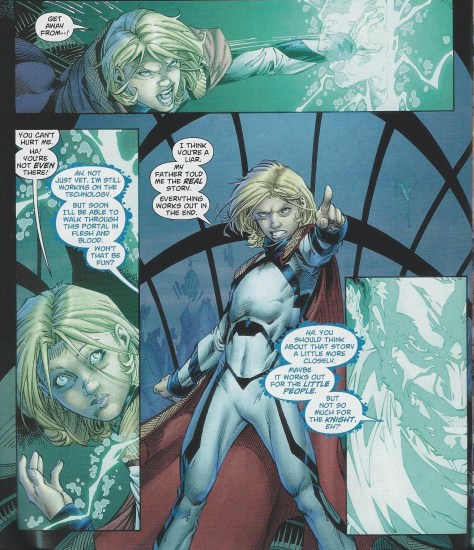
Warrior Women of the House of El.
- Detective Comics #23.4: Man-Bat brings to a point one of the starkest side stories in the Bat titles since the Reboot, that of Kirk Langstrom and his atavistic bat serum. It turns him into a giant bat man capable of flight, superhuman feats of strength, and other bat related abilities. John Layman introduced Langstrom and his wife, Francine, into the New DCU in the landmark 900th issue of Detective Comics. In that issue he also revealed the lengths Francine would go to stay close to her man, even dosing herself with the bat serum. Touching at first, her motivations prove to be less than affectionate. She was hired to get close to him and steal his formula. Modifying it a bit, she became stronger than him and also became addicted to it. Cut to the opening of this issue and Francine flying into a park and abducting a small child from a jungle gym for feasting. Thankfully, a more controlled Man-Bat enters the fray and emancipates the child. Kirk is able to defeat his ex-wife and save the day, and in light of the disappearance of Batman and the descent of Gotham into chaos he decides that with his serum he can be the Bat Man that his city needs. To paraphrase the rest of the plot, the road to Hell is paved with good intentions. The desire to be a hero doesn’t necessarily yield one, especially when a de-evolutionary serum is thrown into the mix. Frank Tieri writes this issue with Scott Eaton on pencils, and overall the product feels like an extended backup feature from Detective, which is definitely a compliment. Man-Bat has been crafted into a very compelling character striding the line between hero and villain with great alacrity.
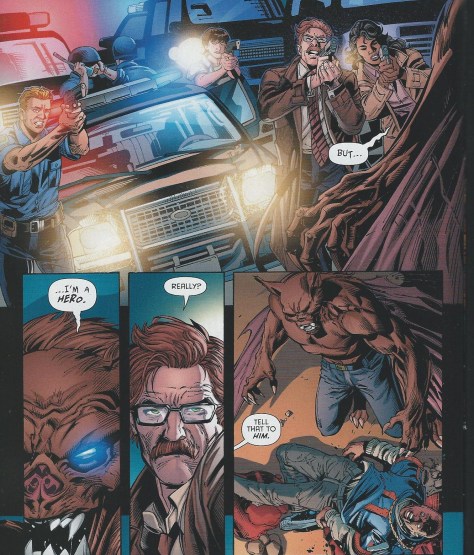
Harsh Justice.
- Superman #23.4: Parasite was REALLY good. I’m not the biggest Parasite fan, but this issue had me hooked. I’ve been looking forward to both Aaron Kuder’s story and art. The art is solid, obviously, but Kuder also has a way with words. When describing Suicide Slums, in which the main character, Joshua Michael Allen lives, Kuder compares it to “If Gotham and Detroit had a love child, this would be it.” Allen is a dirtbag bike messenger that just coasts through life leaching off others until he gets assaulted by a giant plasma monster. Afterward, his leg is broken and his livelihood taken from him. When S.T.A.R Labs calls to examine him he is inadvertently transformed into a shriveled purple monster with serious periodontal issues and an insatiable hunger. Soon he realizes that the only way to feed the hunger is to suck the life force out of the people he comes in contact with . . . killing them. This barely sates his ravenous appetite until the Parasite comes into contact with Superman and is SUPERcharged with the power dripping off the Man of Steel’s enhanced Kryptonian biology. When Supes hits Parasite with his heat-vision the blast that would level buildings and kill most living things actually makes the burgeoning supervillain balloon and take on many of Superman’s abilities. Being a smart cookie and owing to Allen’s noob status as a villain Superman eventually figures out how to contain him and he is sent to Belle Reve. However, he leaves Parasite with a taste of Kryptonian power and like a man-eating shark, Parasite’ll feed on other things to survive, but seek out his desired prey just for the taste. That prey is Superman. With the opening of prisons in Forever Evil #1 Parasite is once again released upon the outside world and free to feed. Aaron Kuder performed a miracle with this issue, basically ramrodding a complete origin story into a twenty page comic, and what’s more he makes it both succinct and entertaining, not at all rushed or half-cocked. There are no questions left about what happened to Parasite or what his motivations are. Seasoned comic book writers have tried and failed this month to do what Kuder did here, and to my knowledge this is his first time writing. Well done all around, Mr. Kuder. You’ve made me a believer and a fan of Parasite.
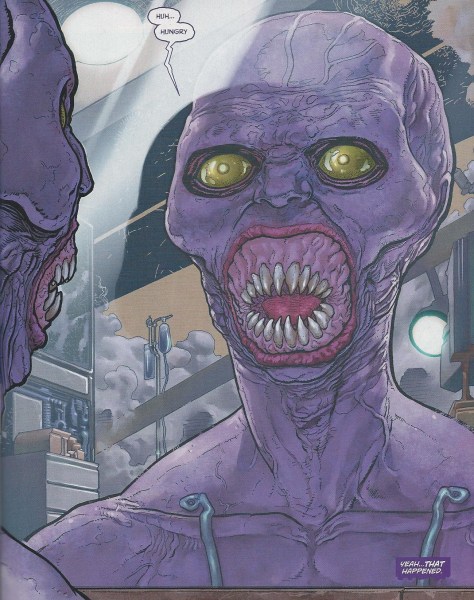
That Happened.
- Batman #23.4: Bane was yet another issue that falls under the category “a means to an end.” All this issue did was set up Bane’s connection to the coming series Forever Evil: Arkham War. Bane is going to Gotham with his army of mercenaries from Santa Prisca to take vengeance on the Court of Owls and presumably on Batman, even though the word is out that Batman and the Justice League are dead. It is never broached as to whether Bane is aware of the rumors or not, so I choose to assume that he doesn’t know or he would have mentioned it. Breaking Batman is one of the things he holds onto to make himself feel adequate. Should he know that someone else killed Batman I think he would have gone into a berserker rage and made sure to put them on his list. Peter Tomasi is a fantastic writer, but in this issue he really didn’t do anything new or provocative. Let’s chock this up to” too much on his plate” and move on.
-
Batman & Robin #23.4: Killer Croc was a very pleasant surprise. I am not overly aware of writer Tim Seeley’s former work, but I am a fan of artist Francis Portela so I gave it a shot. It opens with a Gotham City SWAT team moving through the sewers in full tactical gear. Their aim is not mentioned. However, from a culvert at their feet Croc’s eyes are visible to us, but not to his . . . guests’. Needless to say, Croc waits for a good moment and gives many of them the last surprise of their lives. A few do escape, wounded, and stumble upon vagrants living in the sewers. Asking for help, they are brutally assaulted by the homeless masses who are acolytes of Croc. While all this brutality goes on in the issue, Seeley injects several flashbacks to Croc’s youth as a kid with a nasty skin condition that gives him crocodiles skin, making him an outcast with children his own age and with his aunt who takes care of him. Growing up he is still treated like a freak and his gentle soul exploited by bad people. As the narrative continues in the present the two surviving SWAT cops try to make it out, only for one to find a dead one armed police detective strung up blocking their exit. This is the turning point of the issue. Croc didn’t kill this man, the SWAT cops did! They were a dirty unit and the one armed cop, Det. O’Hoolihan wouldn’t play ball with their racketeering so they shot him and tossed his body into Gotham Harbor. But later they got a note telling them to come to sewer at the harbor with money in exchange for evidence against them. Obviously, it wasn’t O’Hoolihan who sent the message. Obviously it was Croc, setting a trap and savoring the kill of each and every man and woman in that unit, often times in front of one another so the survivors could dread their turn after seeing the bloody mess he made of their fellows. Their terror is palpable and not just a little bit satisfying to the reader. So Croc finally, after mangling the final cop, puts him out of his misery as the latter screams to know “what it was all about?” The assumption, considering Croc’s criminal record and hatred of the law, is that he just jumped at the opportunity to kill some cops and have some fun. But after all the flashbacks to Croc’s alienating history based solely on his bestial appearance and his narration of human being being themselves cruel animals that fall under the most primitive drives, there is one last flashback to Croc’s childhood with his abusive aunt. Sitting on a stoop getting berated by local kids, a one armed cop walking his beat brings Croc some ice cream and tells him that he is not only not a freak, but that he has the potential to be something great if he believes in himself. When there is such a scarcity of people in the world that show genuine kindness and mercy, the loss of such people over petty things like grift money and corruption is a jagged pill to swallow, and Croc, realizing that life isn’t fair, made it a little bit more so by staging his little hunt in the sewers and turning the hunters into mewling game. After the killing and the bloodletting cease, he has his people in the sewer take down O’Hoolihan’s body, make a funeral pyre and give him a Viking funeral into the harbor. All the while, as a eulogy to a good man, Croc tells the outcast people of Gotham under his protection the same lessons that the departed policeman told him. People will tell you that you are nothing and spit on you, but you can prove them wrong and show them what true strength looks like. I’m not the biggest fan of Killer Croc, but Seeley’s story about the man turned into a beast by society’s shunning, but maintaining a strict sense of honor and loyalty to virtue really resonated and Portela’s artwork was an integral part in conveying the ferocious anger and consequent sadness of the title character throughout the harsh moments of his life. This issue was an unexpected gem.

Evil Can Be Killed, But Kinnness Never Dies.
- Batman: The Dark Knight #23.4: Joker’s Daughter was unnecessary. The concept of Duela Dent has been intriguing in the past, but writer Ann Nocenti kind of went off the reservation on this one. Duela is a messed up girl that had an idyllic childhood and yet still grew up twisted. So far it still retains promise. But then she runs away and tries to live in a subterranean community of former Arkham inmates and vagrants They don’t listen to her until she finds the Joker’s face floating in the water, from when he jumped into the underground river in Batman #17. She of course puts it on and magically people start listening. I think what bothered me most was the pretense that she stands for something when really the subtext is that she stands for nothing. The Joker doesn’t stand for anything, and in the event that he has a pet project his actions, insane though they may be, work towards actualizing the desired end. Her actions and historical contexts fall far from reconciling one another. Annoyance aside, there is nothing substantial to take away from the issue. A real pity . . .
-
Justice League of America #7.4: Black Adam was a pleasant surprise as well, when it shouldn’t have been relegated to being a surprise in the first place. Black Adam is a fantastic character and has fantastic potential. With Geoff Johns’ incredible foul up of his SHAZAM! backup feature in Justice League the concept of Black Adam also falls under suspicion. However, like all the other issues conceived of by Geoff Johns and written by someone else, this issue comes off beautifully. Sterling Gates does the honors on this one and Edgar Salazar provides pencils. We had been told of Black Adam’s past in his North African nation of Kahndaq in the pages of Justice League #19, wherein four thousand years ago an invading force under the rulership of a man named Ibac the First took control of his country and murdered his people by the thousands. Teth Adam whose sworn duty it was to defend his people did so and turned Ibac and his men to stone as a reminder to those that would oppress the people of Kahndaq. Though the statues remain, Kahndaq has sunken into chaos not unlike the Egypt and Syria of our reality. And like those countries there is a schism of action by those being oppressed. The characters of Amon and Adrianna are reintroduced into the New DCU to illustrate this schism. These two characters were once Osiris and Isis in past incarnations of the Black Adam story when they said the name of the Wizard, but this time are just normal middle eastern siblings trying to make the world right through non-powered means. Adrianna is a non-violent protester that used social media to broadcast the struggle to world audiences. Amon has gotten involved in a militant movement called the “Sons of Adam,” who still view Black Adam as their nation’s savior. Black Adam was reduced to dust in his confrontation with Captain Marvel in the pages of Justice League, but as seen in Justice League #22 that same superhero deposited the collected ashes in the Kahndaqi desert out of respect. The Sons of Adam intend to read a passage from a lost scroll of the Egyptian Book of the Dead to resurrect him so that he can aid their people. The military crash the ritual and Adrianna who was tipped off follows to warn her brother. Amon is shot before he can finish the incantation, which Adrianna does for him, bringing forth Teth Adam from the land of the dead. Adam makes short work of the army and goes to the dictator of Kahndaq to do as he did millennia ago. Amon seemingly dies and the pacifistic Adrianna takes up a fallen AK-47, while casting off her beliefs in non-violence. Black Adam cuts a very different figure from his shoddy representation in Justice League’s back up stories. The pettiness is gone. Upon being awoken and his followers prostrating themselves before him he chides them to never kneel to anyone. When he faces the current day despot ruling Kahndaq (who chose to take the name Ibac for its connotations) Black Adam crushes him with the stone throne of that first tyrant. Not long after that Black Adam sees the Crime Syndicate’s announcement to the people of Earth-1, “This World Is Ours.” His reply? A very angry exclamation of, “This world belongs to NO ONE.” Black Adam is a very violent man, but he is a fair man. He can be very harsh, but he is a proponent of freedom and individualism. Geoff Johns really blew it when he first wrote him into the New DCU. I would love to know who actually came up with the depiction here, because while I want to believe that Johns is still capable of writing compelling characters like this, he has a VERY bad track record over the last two years. Either way, this issue was very informative and definitely an important issue for the overall storyline of Forever Evil.

The Face of Freedom.
- Wonder Woman #23.2: First Born is one of those rare issues this month that basically could be an issue of the regular series. The Count Vertigo issue was the only other example that comes to mind. Both First Born and Count Vertigo are written by their regular series writer, Brian Azzarello in the case of First Born, and drawn by regular series artists. The only thing that separates them from regular issues is the absence of their titular heroes. Wonder Woman doesn’t appear in a single frame. There is a prophesy illustration with a skeleton that might be her’s, but that hardly counts considering the lack of costume or armaments to prove it’s actually her. What it does is depict Apollo gaining custody of his eldest brother, the First Born’s unconscious body, and having his trio of modern day urban oracles channeling the forgotten god’s history. We’ve heard the story piecemeal over the past year since the awakening of the First Born, but this issue strings those pieces together and gives us a visual narrative of it as it unfolds. Zeus has a son by his lawful wife, Hera, but a witch foresees that this child would one day rule Olympus alone, so Zeus had him killed to protect his throne. The baby didn’t die, but rather was raised by animals and became a terror of mankind. When he finally grew to manhood and had built an empire and an army at his back he assaulted Olympus to take what was his. Zeus soundly defeated him, took his weapons and armor and consigned him to the bowels of the Earth to be forgotten. When he awoke the prophesies began anew. Zeus proclaimed that if he ceased to be or left Olympus the throne would be open for the First Born to take, if he could manage it. There also was a prophesy that there would be a great war and great fire before the throne was decided. In the final image one man is standing, one man is burning, and a woman is watching. The woman is thought to be Wonder Woman, and the men are Apollo and the First Born, but the identity of the man standing and the one burning is not certain. Brian Azzarello has a very singular vision of this title that has stretch over two full years. This issue cuts to the very heart of both the main character of Wonder Woman and the mythological relevance of her place in the DCU. What also is exciting is that this issue feature the VERY first depiction of Zeus himself. He has been talked about endlessly, and his desertion of the throne of Olympus has caused no end of strife, but we have never seen him. Here we see a figure that is very much like Hera when we first beheld her. In the beginning she was totally nude, but for a cloak of bright green peacock feathers. In this issue, Zeus is a vibrant, muscular, bearded man wearing a cloak of feathers (they seem to be either eagle feathers or swan feathers) and nothing else. The depiction seems apt, considering Ancient Greek depictions of masculinity vis-a-vis naked soldiers and athletes. Overall, very well done and intriguing storytelling.
-
Adventures of Superman #5
provides two tales of the Man of Steel by writers Nathan Edmondson and Kyle Killen, and artists Yildiray Cinar and Pia Guerra. In Edmondson and Cinar’s tale, “Infant in Arms”, an alien ship crashes to earth outside of Jackson, Missouri. The military try to blow it up before its occupant can exit, but Superman steps in and reveals that like himself, the extraterrestrial ark holds an infant that looks exactly like a human baby but for her purple skin. A dying sentry within the ship informs Superman that she is Princess Aria, but is able to say no more before death takes him. Soon militants from her world come to kill her. Superman not only must keep her safe, but also take care of her and her many infantile needs. The story has no real ending, but gives endless possibilities for one. Killen’s story depicts one of the most tragic realities of Superman’s life and something that most people are reticent to admit: Superman is not infallible. Two boys who idolize Superman sit in a parked car on railroad tracks. The driver, Mike, is convinced that Superman will save them and they will be able to meet him. His companion Henry is not so sure. It is not said outright that they are brothers, but the implication at the end infers it greatly. The issue proceeds with Lex Luthor perpetuating flashy crime after flashy crime and Superman stops them each in turn, but in doing so he fails to stop the train and Mike is killed in his car, waiting. When Luthor is asked in prison by a guard whether losing to Superman gets boring, Luthor demonstrates that he isn’t actually losing, and betrays the genius of his strategy. Luthor never would engage in an endeavor that he would fail at outright. In the short term he does lose and is imprisoned for short periods of time, but in the long run, by distracting Superman with his elaborate crimes he prevents the Man of Steel from saving people and those left behind are filled with resentment. True to his vision, Henry ends the issue by going through Mike’s room, ripping down all his Superman paraphernalia and burning them outside his home. “In that way you can think of me as Johnny Appleseed spreading a healthy disdain fro Superman’s nonsense.” The scary thing is that Luthor is correct. People don’t want to believe that Superman can fail, and when he was depicted in a manner of not being able to save everyone in this summer’s Man of Steel movie, people went NUTS over it! Superman isn’t Supergod, he’s SuperMAN. Outside the comic and inside, people seem to be unable to accept his limitations and that very weakness in humanity is a commodity that Luthor capitalizes on like any ruthless business man. The Adventures of Superman title is really amazing in the very poignant tales it weaves of Superman and this issue epitomizes that promise.

The Evil Genius of Lex Luthor
- Jupiter’s Legacy #3 takes a very sharp turn. After gaining superpowers in the 1930’s by visiting a mysterious island that adventurer Sheldon Sampson sought out after seeing it in a dream, he and his companions became the guardians of America through the decades. The title centers around these aged paragons of heroics and justice faltering in the 21st century as their children become drunken reprobates and partiers and the country yet again stands on the brink of financial ruin as it was in the 30’s when they got their powers. The question that pervaded the first two issues is what they should do about it. The Utopian (Sheldon Sampson) believes that it is not their job to enforce policy or intervene in politics, only watch and support the elected officials and let them do whatever they feel is right. His brother Walter, who is both a genius and a telepath, believes that they need to intervene and aid the elected officials and make sure the corrupt ones don’t sour the barrel. There are legitimate points on either side, but in the first two issues writer Mark Millar tends to depict Walter as a voice of reason and fairness. He doesn’t draw the line on liberal or conservative or democrat or republican, only what things need to be done to fix the current economic downfall. Contrarily, Sheldon is portrayed as a starry eyed idealist that defines laissez faire and reacts harshly to anyone that would burst that bubble or question his mandates. He is also a very harsh father that takes a hardline of his son and daughter’s behaviors and openly calls them disappointments. This issue flips that concept on its head. Sheldon’s daughter Chloe was revealed to be pregnant last issue and the father of her child was the son of one of the Utopian’s former villains. This man, Hutch, works primarily as a high end drug dealer. The issue begins with Hutch meeting the Utopian and being told rather civilly that he won’t be allowed to have a part in Chloe or her baby’s lives. However, elsewhere plots are brewing and they quickly develop as Sheldon is lured into a trap set by his own allies who K.O. him after he is pummeled by a meteor they hurdled at Earth which he intercepts. Others including Walter go to his home and murder his wife, Grace, and attempt to murder Chloe and her unborn child, but for the intervention of Hutch, who warps his lover, child, and himself across the world numerous times until they are untraceable. In the meantime a legion of super-powered “friends” beat the fallen Utopian to a pulp until his son Brandon arrives to deliver the final deathblow to his father. While doing so, there is of course the inevitable “I didn’t fail you, you failed me” speech, and to an extent everything Brandon said has merit, but not to the extent that his actions invoke. The death of his mother and the attempted murder of his pregnant sister are abhorrent and they cast a very bad light on the figure of Walter who seemingly was a pillar of reason before. Many things can be said of Mark Millar’s writing, but regardless of what faults there are, one guiding truth is that his plots are very socially aware and deliver very moving point/counterpoint arguments within. One man is a monster in one issue only to be made into a martyr in the next and one man cast as a saint turned into an inhuman monster. Children are misled and turned against their parents. Youths falter through self doubt and confusion in the quest for significance. Jupiter’s Legacy is a very compelling series in only three issues that begs to be read for both Millar’s very stark, complex drama and the gorgeous illustrations by fellow Scotsman, Frank Quitely. Even for those who do not like Millar this is a series that should be given a chance free of prejudice.
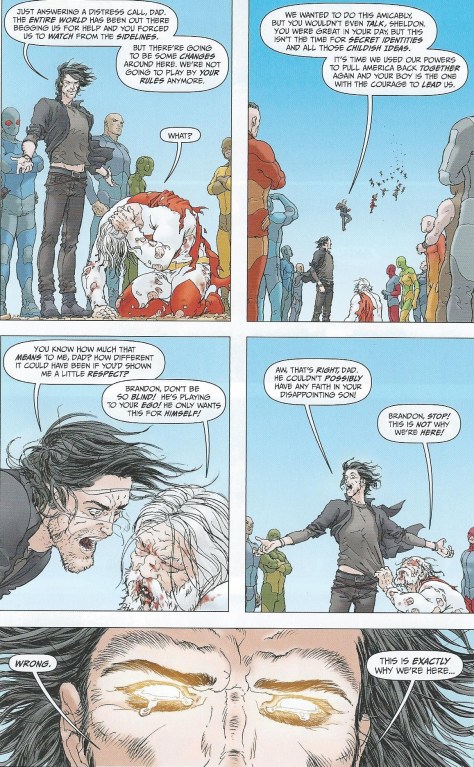
Fathers and Sons.
-
The Wake #4
continues Scott Snyder’s ingenious limited series delving into the science of the supernatural. His work on the seminal American Vampire series not only catapulted him into comics superstardom it provided a refreshing breath of fresh air to the vampire genre made stagnant and putrescent by hacks like Stephanie Meyer and other teen romance writers. Uniting with artist Sean Murphy, who aided Snyder on his American Vampire: Survival of the Fittest limited series, the two tackle another underutilized cyptozoological wonder: mermaids, or to be more fair, mer-folk. Mer people have existed in one form or another in many mythologies throughout the world regardless of culture. This issue contains a fascinating myth of a fabled Dutch city and its run in with a mermaid. While this series is only four issues into a ten issue run Snyder is still holding many cards close to his chest. However, the story so far is that marine biologist Lee Archer is brought into a super secret deep sea drilling station by a government agency with a ragtag group of scientist and criminals to examine and contain a fishman caught near the rig. This is the factual basis of merfolk lore and like the vampires of Snyder’s other series, endowed with many scientifically explained features while simultaneously shrouded in numerous mysteries. Snyder makes them seem perfectly plausible, but also incredibly wondrous like many creatures one would find near the ocean floor that actually exist. The merman is not as weak as they anticipate and it frees itself and calls its fellows down on the station. The remnants of the expedition are overrun and attempt an escape. This issue has them finding temporary sanctuary in the emptied but pressurized pipeline leading from the drill to the station. But the mer people are on either side and there is no escape. However, the aforementioned fable of the Dutch city of Saeftinghe gives Lee an idea that could just save them. The idea stems from a very real experiment the Navy has been conducting over the past several years outside of the comic that has maimed many marine mammals, most notably whales and dolphins. Snyder doesn’t justify its usage and through Lee actually makes a compelling case for its cessation. However, when dealing with evil marine men that are ravenous killing machines certain exceptions can be made. It’s only four issues in but the story and art make it a package deal of entertainment for the intellect and the soul.

The Legend of Saeftinghe.
-
The Unwritten #53 brings forth the fourth installment of a five issue Unwritten/Fables crossover. An evil ebon cloaked entity calling himself Mr. Dark has descended upon the land of Fables, taking lives, possessions, land, and even families. Snow White is made into a darker version of herself and made his consort, her husband the Big Bad Wolf is chained in a dungeon, and Snow White and Big B’s children adopted as Dark’s. Boy Blue and Rose Red are murdered. The Fables live in the Enchanted Grove, constantly living in fear. To remedy this the magic users of Fabletown summon Tommy Taylor and his friends Sue Sparrow and Peter Price to intercede. Since they fall outside the stories that comprise Fabletown, they are an unknown variable that could throw Mr. Dark off his game. Last issue, both Lizzie Hexam and Pullman were drawn from the ether and told Dark exactly who Tommy is and what he is. They also revealed that there are other worlds and other stories outside that are open for conquest. The stakes are high and everyone settles their affairs before the final battle with Dark. Prince Ambrose (The Frog Prince) has the Enchanted Grove cut down for Gepetto to sculpt into an army of animated wooden soldiers. Once cut down the Grove can never be regrown. As the battle commences more Fables loose their lives setting the stage for the apocalyptic finale that will determine the future of two series. No pressure. The Unwritten has been a jaw dropping comic since its first issue. Coupled with the iconic Fables this title establishes its place in comic history.
-
T.H.U.N.D.E.R. Agents #2
begins the next incarnation of T.H.U.N.D.E.R. Agents under the IDW imprint. The DC iteration that wrapped up two years ago was phenomenal. Two issues in and this new series appears to uphold that tradition. The DC series written by Nick Spencer was a swansong to all that had been before. The original runs beginning in the 60’s and marching forward through the 80’s and 90’s are all honored and Spencer’s Agents inherit their T.H.U.N.D.E.R. devices and code-names from the original bearers, essentially using them to end the cycle of violence that begat them and become the final Agents of T.H.U.N.D.E.R. Those survivors from the beginning of T.H.U.N.D.E.R either bow out or are put down. The starkest moment comes in the last issue of the first half of Spencer’s run when the daughter of the original Dynamo, Len Brown, and the Iron Maiden has her mother murdered by a woman the ironclad villainess had grossly disfigured in a terrorist attack. All loose ends were sewn up. This series, conversely, begins at the beginning as The Higher United Nations Defense Enforcement Reserves try to find agents to wield the devices created by the world renowned genius, Prof. Jennings, who mysteriously vanished before explaining them. Last issue they selected Len Brown to wield the Thunder Belt to become the agent code-named Dynamo. Inserted via airlift into Kashmir, Dynamo and the agent code-named NoMAN attempt to invade the Iron Maiden’s cave lair. Randomly injected into the narrative is a hazy memory of T.H.U.N.D.E.R. Director Kane’s childhood of daring-do with her red headed sister, Kelly. Seemingly irrelevant, its significance come through later in the issue. Meanwhile, Dynamo meets two T.H.U.N.D.E.R. moles within Iron Maiden’s ranks, and eventually the lady herself. As it was in the first issue of T.H.U.N.D.E.R. Agents from 1965 Iron Maiden captures Dynamo. Both issues of the series end enticingly on high drama cliffhangers. Writer Phil Hester really does have a knack for writing this complex super-hero/espionage/sci-fi title. I highly suggest picking up both the first and second issues of this series and get in on the ground floor.
So ends the week and Villains Month. Next week we get back to the ongoing storylines put on hold from August. Though it’ll be nice to get back to normal, it’ll also be sad seeing these characters and their compelling albeit villainous deeds relegated to uncertainty. It was a good month.
Disclaimer: I do not own the rights to any of these images and give credit to those whose work they are.
Illustration Credits:
Justice League #23.4: The Secret Society: Art by Szymon Kudranski, Colored by John Kalisz.
Aquaman #23.2: Oceran Master: Drawn by Geraldo Borges, Colored by Rod Reis, Inked by Ruy Jose.
Batman/Superman #3.1: Doomsday: Drawn by Brett Booth, Colored by Andrew Dalhouse, Inked by Norm Rapmund.
Detectice Comics #23.4: Man-Bat: Drawn by Scot Eaton, Colored by Jeromy Cox, Inked by Jaime Mendoza.
Superman #23.4: Parasite: Art by Aaron Kuder, Colored by Tomeu Morey.
Batman & Robin #23.4: Killer Croc: Art by Francis Portela, Colored by Tomeu Morey.
Justice League of America #7.4: Black Adam: Drawn by Edgar Salazar, Colored by Gabe Eltaeb, Inked by Jay Leisten.
Adventures of Superman #5: Art by Pia Guerra, Colored by Matthew Wilson.
Jupiter’s Legacy #3: Art by Frank Quitely, Colored by Peter Doherty
The Wake #4: Art by Sean Murphy, Colored by Matt Hollingsworth
